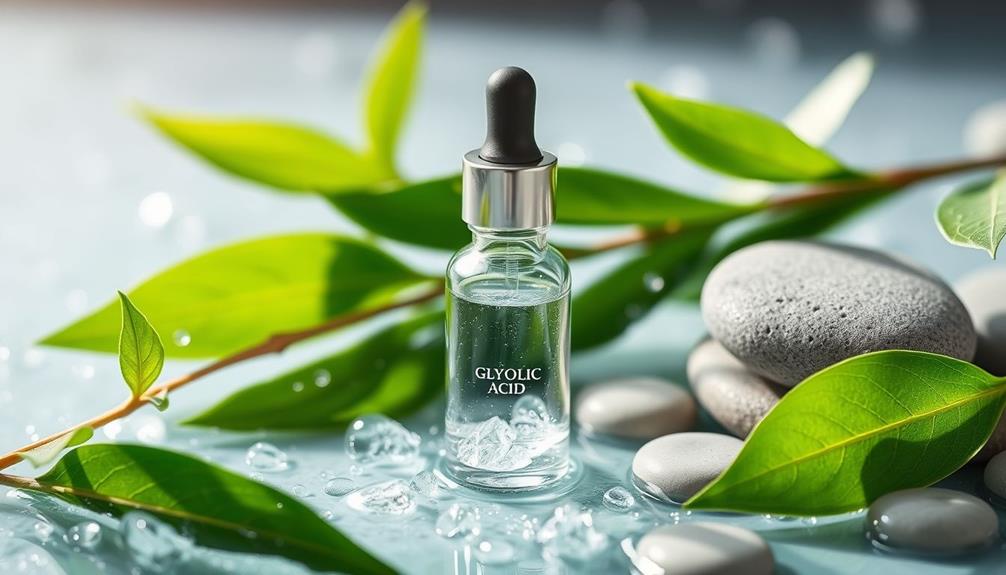Glycolic acid is a powerful weapon in the fight against acne and for achieving clear skin. This potent alpha hydroxy acid penetrates deeply, gently exfoliating your skin and unclogging pores. By breaking down the bonds between dead skin cells, it speeds up cell turnover, which helps prevent future breakouts. Regular use can reduce inflammation and improve the overall texture of your skin, leaving it smoother and healthier. Additionally, it can help fade marks left by previous acne, known as post-inflammatory hyperpigmentation. Stay tuned for valuable tips and product recommendations to make the most of glycolic acid’s benefits for your skin!
Key Takeaways
- Glycolic acid exfoliates the skin by dissolving dead skin cell bonds, preventing clogged pores and reducing acne breakouts.
- Regular use promotes cell turnover, helping to fade post-inflammatory hyperpigmentation and improve overall skin texture.
- Clinical studies show significant reductions in acne lesions and inflammation, enhancing skin clarity with consistent application.
- Dermatologists recommend starting with lower concentrations to minimize irritation, gradually increasing as skin tolerance improves.
What Is Glycolic Acid?
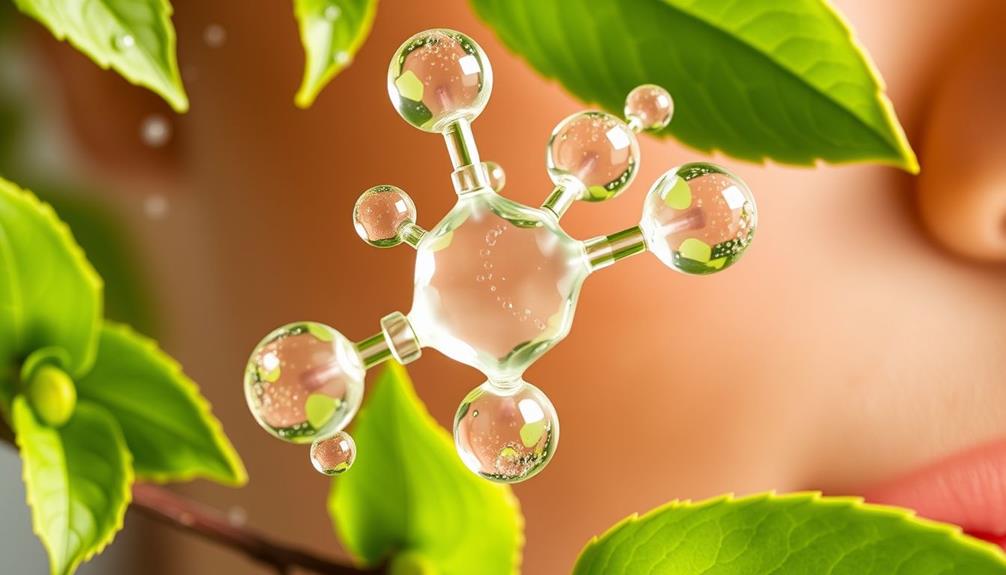
Glycolic acid, a powerful alpha hydroxy acid (AHA) derived from sugarcane, offers effective exfoliation that improves skin texture and promotes cellular turnover. It's one of the most popular AHAs in skincare formulations due to its small molecular size, which allows for deeper penetration into the skin. This property makes glycolic acid particularly beneficial for acne treatment, as it targets surface-level skin issues efficiently.
Additionally, incorporating natural remedies can further enhance your skincare routine, such as using cold compresses for soothing effects natural fixes for uneven eyes.
Its exfoliating properties work by dissolving the bonds between dead skin cells, helping to prevent clogged pores that can lead to acne formation. With regular use, glycolic acid not only enhances the effectiveness of other acne treatments but also promotes better absorption of topical products. This means you'll get more out of your entire skincare routine.
You'll typically find glycolic acid in various skincare formulations, including serums, lotions, and professional peels, with concentrations ranging from 5% to 30%. By incorporating glycolic acid into your regimen, you can achieve a smoother skin texture and experience improved cellular turnover, making it a must-have ingredient for anyone struggling with acne or looking to enhance their overall complexion.
How Glycolic Acid Works

Understanding how glycolic acid works reveals its effectiveness in treating acne and improving overall skin health.
As an alpha hydroxy acid (AHA), glycolic acid excels at exfoliating by dissolving the bonds between dead skin cells. This process enhances skin texture and promotes smoother, clearer skin.
Its small molecular size allows it to penetrate deeply, unclogging pores and reducing the occurrence of acne breakouts.
Additionally, incorporating essential oils like Tea Tree and Lavender through essential oils for skin health can further complement the acne-fighting properties of glycolic acid.
Regular use of glycolic acid is key to enhancing cell turnover, which helps fade post-inflammatory hyperpigmentation (PIH) that often follows acne.
Clinical studies show that consistent application can considerably reduce acne lesions and overall severity of acne, making it a powerful acne treatment option.
Additionally, glycolic acid possesses mild anti-inflammatory properties, which help soothe existing acne lesions, effectively reducing inflammation and redness in the skin.
Incorporating glycolic acid into your skincare routine can be a game changer.
With its dual action of exfoliating and calming, it not only addresses current acne issues but also helps prevent future breakouts, leading to healthier, clearer skin over time.
Benefits for Acne-Prone Skin
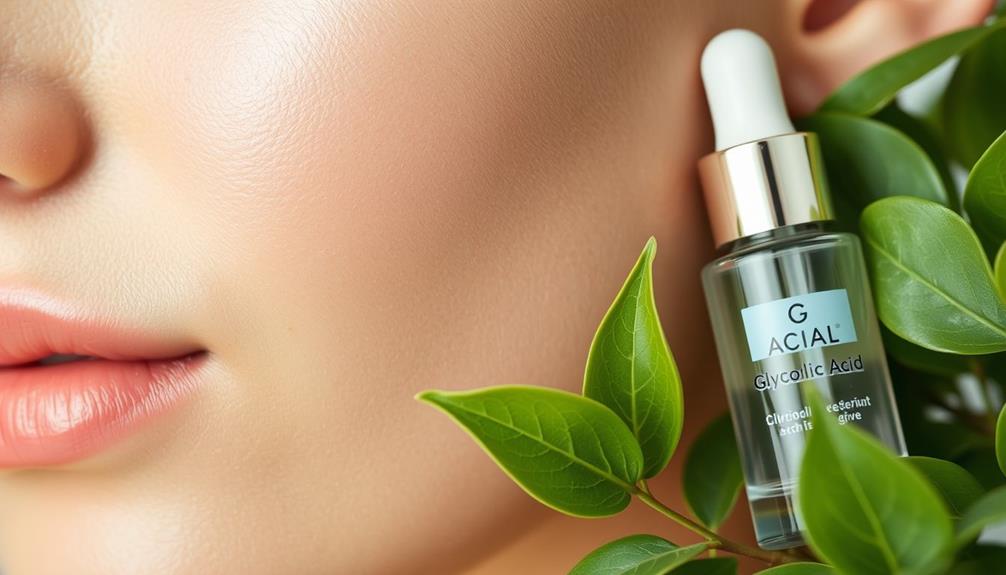
Glycolic acid offers significant benefits for your acne-prone skin by reducing inflammation and breakouts.
Its ability to improve skin texture means you'll not only see fewer blemishes but also a smoother complexion over time.
Additionally, incorporating natural alternatives like essential oils can complement your skincare routine, providing essential oils for skin health while tackling acne.
Reduces Inflammation and Breakouts
One of the key benefits of incorporating glycolic acid into your skincare routine is its ability to effectively reduce inflammation and breakouts, making it ideal for acne-prone skin.
Glycolic acid promotes exfoliation, helping to clear clogged pores and prevent future breakouts. This powerful ingredient accelerates cell turnover, which means dead skin cells are shed more quickly, reducing one of the common contributors to acne formation.
Additionally, consistent use of glycolic acid can lead to healthier hair as well, as monitoring skin health is often linked to overall well-being, including scalp conditions. hair treatments for damaged hair can complement your skincare regimen, enhancing results.
With regular use, you'll likely notice a significant decrease in acne lesions and overall acne severity. Dermatologists often recommend glycolic acid for individuals dealing with mild to moderate acne, as it works to unclog pores and minimize the frequency of breakouts.
By consistently using glycolic acid in your daily regimen, you can enjoy clearer skin while addressing the inflammation that often accompanies acne.
In essence, glycolic acid not only targets the existing acne but also helps to create a smoother, healthier canvas for your skin, enhancing your overall complexion.
Embracing this potent ingredient can be a game-changer in your battle against acne, leading to a clearer and more confident you.
Enhances Skin Texture Improvement
Incorporating glycolic acid into your routine can greatly enhance skin texture, making it an invaluable asset for anyone dealing with acne-prone skin.
This powerhouse ingredient works by exfoliating the skin, dissolving the bonds between dead skin cells, and promoting cell turnover. As a result, you'll notice a smoother skin texture and reduced likelihood of clogged pores, which can lead to breakouts.
Additionally, engaging in practices that promote self-exploration through body awareness can complement your skincare regimen by enhancing overall well-being.
Regular use of glycolic acid not only helps to improve skin brightness but also diminishes post-inflammatory hyperpigmentation (PIH) from past acne lesions. Over time, you'll achieve a more even skin tone.
Clinical studies show that glycolic acid peels can greatly reduce the appearance of shallow acne scars by stimulating collagen production, which is essential for skin healing.
Additionally, the small molecular size of glycolic acid allows it to penetrate deeply, enhancing the effectiveness of other topical acne treatments. By removing dull, dead skin cells, glycolic acid reveals fresher skin underneath, contributing to an overall improvement in skin clarity and texture.
Embracing glycolic acid in your skincare regimen can lead to lasting benefits for your acne-prone skin.
Clinical Evidence and Studies

Recent studies consistently demonstrate that regular use of glycolic acid effectively reduces acne lesions and improves skin texture in those with mild to moderate acne. Clinical trials have shown that glycolic acid serves as a powerful adjunctive acne treatment, leading to significant improvements in acne severity over time.
| Study Source | Key Findings | Treatment Method |
|---|---|---|
| Journal of the American Academy | Reduced acne lesions in participants | Glycolic acid application |
| Journal of Cosmetic Dermatology | Decreased sebum production and improved skin clarity | Glycolic acid peels |
| Various Clinical Trials | Enhanced effectiveness with microneedling | Glycolic acid + microneedling |
| Exfoliating Properties Evidence | Reduced post-inflammatory hyperpigmentation | Glycolic acid exfoliation |
These findings confirm that glycolic acid's exfoliating properties not only help in treating acne lesions but also enhance overall skin texture. Additionally, when combined with microneedling, glycolic acid may further improve skin appearance and reduce acne scars. By incorporating glycolic acid into your routine, you're taking a proactive step toward clearer skin.
Expert Opinions on Glycolic Acid

When considering glycolic acid for acne, expert opinions highlight its effectiveness and importance in crafting personalized treatment plans.
Dermatologists recommend starting with lower concentrations to gauge your skin's tolerance, as this approach minimizes irritation.
Additionally, understanding the emotional dynamics in relationships, such as those seen in BPD push-pull dynamics, can enhance overall self-care practices.
Understanding how glycolic acid works can empower you to make informed choices about your skincare routine.
Dermatologist Recommendations
Dermatologists widely endorse glycolic acid for its ability to effectively unclog pores and reduce acne inflammation.
If you have acne-prone skin, incorporating glycolic acid into your routine can lead to fewer breakouts and improved skin texture.
Experts recommend regular use of glycolic acid, often highlighting its powerful exfoliating properties, which help to eliminate dead skin cells that contribute to clogged pores.
To minimize skin irritation, dermatologists suggest starting with lower concentrations of glycolic acid.
This approach allows your skin to build tolerance gradually, ensuring a more comfortable experience as you incorporate it into your skincare routine.
Consulting with a dermatologist is essential, as they can provide tailored advice based on your specific skin type and concerns.
Mechanism of Action
Glycolic acid works by penetrating the skin and breaking down the bonds between dead skin cells, which helps prevent clogged pores and reduces acne. By exfoliating the skin, it facilitates the removal of impurities and encourages new cell turnover, resulting in improved skin texture. According to dermatologists, glycolic acid is an effective acne treatment, particularly for those with mild to moderate acne.
Here's a quick overview of glycolic acid's benefits:
| Action | Benefit |
|---|---|
| Exfoliating the skin | Prevents clogged pores |
| Reduces sebum production | Minimizes oily skin |
| Decreases acne lesions | Reduces the severity of breakouts |
Clinical studies support these claims, showing a significant reduction in acne lesions with regular use of glycolic acid-based products. Additionally, its ability to enhance skin texture contributes to a clearer complexion. However, individual responses to glycolic acid may vary, making it essential to consult with a dermatologist for personalized treatment plans that maximize its effectiveness in managing acne.
Individualized Treatment Plans
Understanding how glycolic acid works lays the groundwork for creating individualized treatment plans that cater to your specific skin needs and concerns.
When considering glycolic acid for acne treatment, it's vital to recognize that individual responses can vary greatly. Your skin type and unique concerns should dictate the concentration of glycolic acid in the products you choose.
Consulting a professional is important to determine the right concentration and frequency of use. This minimizes irritation while maximizing the effectiveness of glycolic acid in treating your acne. Regular use can promote cell turnover, improve skin texture, and reduce breakouts, but it must be tailored to your skin's tolerance.
Utilizing personalized skincare quizzes can also guide you in selecting the right glycolic acid skincare products based on your individual needs and goals. These quizzes consider various factors like your skin type and sensitivity levels.
Combining professional consultation with personalized quizzes guarantees you develop a thorough and effective approach to managing your acne. By prioritizing individualized treatment plans, you set yourself up for clearer, healthier skin.
Incorporating Glycolic Acid Into Your Routine

To effectively incorporate glycolic acid into your skincare routine, start with lower concentrations and gradually increase usage to allow your skin to adjust. Begin with products containing around 5% to 10% glycolic acid, using them two to three times a week. This gentle approach helps minimize irritation while promoting effective skin treatment.
Glycolic acid works wonders by removing dead skin cells, preventing clogged pores, and helping reduce acne breakouts. As you incorporate glycolic acid, you'll notice improvements in uneven skin tone and overall skin texture.
For best results, apply glycolic acid products at night, as this reduces UV sensitivity. Always follow with a broad-spectrum sunscreen during the day to protect your skin from harmful rays.
To combat potential dryness and irritation, pair glycolic acid with a hydrating moisturizer. This balance guarantees your skin remains nourished while reaping the benefits of glycolic acid.
With consistent application, you can expect visible results in just a few weeks, making it a valuable addition to your skincare routine for clearer, smoother skin.
Potential Side Effects to Consider
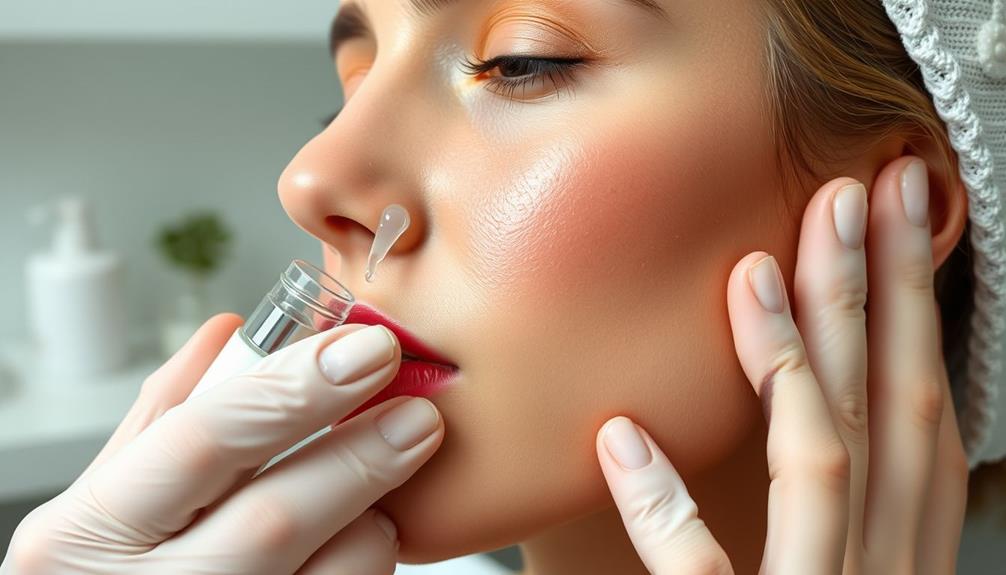
While glycolic acid offers numerous benefits for acne treatment, it's important to be aware of potential side effects that may arise during its use.
Common side effects include redness, stinging, and irritation, especially when you start using higher concentrations. To minimize these effects, consider doing patch testing before applying it to your entire face, allowing you to gauge your skin's sensitivity to glycolic acid.
Increased sun sensitivity is another significant concern. You'll need to apply a broad-spectrum sunscreen with at least SPF 30 daily to protect your skin.
As your skin adjusts to glycolic acid, you might experience dryness and flaking. Incorporating a gentle moisturizer into your routine can help alleviate this discomfort.
It's also essential to avoid over-exfoliation, which can compromise your skin barrier. Using glycolic acid too frequently or combining it with other potent actives may lead to increased irritation and sensitivity.
Glycolic Acid Products to Try

When it comes to choosing glycolic acid products, you'll want to evaluate the top options available and how to apply them effectively.
Understanding the expected results can help you set realistic goals for your skin.
Let's explore the best products, tips for application, and the improvements you can anticipate.
Top Glycolic Acid Products
Explore these top glycolic acid products that can help clear acne and enhance your skin's texture. Each of these options offers effective exfoliation, improving skin texture while preventing buildup of dead skin cells and excess oil.
| Product | Key Benefits | Best For |
|---|---|---|
| Dermatologists Choice Glycolic Peel Cleansing Pads | Clinically shown to reduce acne lesions and improve skin texture | Regular use for acne-prone skin |
| Caudalie Peel Mask | Exfoliates and moisturizes for enhanced radiance | Quick treatment |
| Pixi Glow Tonic | Provides gentle exfoliation with added hydration | Daily use |
For at-home treatments, look for products containing 5% to 10% glycolic acid, which are suitable for most skin types. If you're interested in deeper exfoliation, consider The Ordinary Masque, specifically designed to target acne-prone skin. Regular use of these glycolic acid products can lead to clearer skin and a smoother appearance, making them essential for your skin care routine.
Application Tips and Techniques
To get the most out of your glycolic acid products, it's crucial to apply them correctly and follow a few key techniques. Start by using a gentle cleanser to prep your skin, ensuring it's free of impurities for better absorption. Once your skin is clean, apply glycolic acid products at night, as they can increase sun sensitivity. Always follow up with broad-spectrum sunscreen during the day to protect your skin from harmful UV rays.
Here are some application tips to enhance your routine:
- Start Low and Slow: Begin with products containing 5%-10% glycolic acid and gradually increase the frequency as your skin tolerates it—aim for two to three times a week.
- Hydrate After Application: Use hydrating moisturizers after applying glycolic acid to combat any dryness and maintain skin hydration.
- Consider Chemical Peels: For more intensive acne treatment, look into popular options like Dermatologists Choice Glycolic Peel Cleansing Pads, Pixi Glow Tonic, or Caudalie Peel Mask.
Expected Results and Improvements
Regular use of glycolic acid can lead to noticeable improvements in your skin, including reduced acne lesions and a more even texture.
By incorporating glycolic acid into your skincare routine, you'll promote cell turnover, which helps clear out pores and diminish the severity of acne.
This ingredient is particularly effective in addressing post-inflammatory hyperpigmentation (PIH) caused by previous breakouts, leaving your skin looking clearer and healthier.
For ideal results, consider trying products like Dermatologists Choice Glycolic Peel Cleansing Pads, which are designed to unclog pores and reduce inflammation.
Expect to see visible results after weeks of consistent use, so patience is key.
As you stick to your routine, you'll notice improvements in skin brightness and overall texture.
Combining With Other Ingredients

Combining glycolic acid with other effective ingredients can greatly enhance its acne-fighting properties. By strategically pairing glycolic acid with specific compounds, you can target acne more effectively and achieve clearer skin.
Here are three potent combinations to evaluate:
- Glycolic Acid and Salicylic Acid: This duo works wonders as salicylic acid unclogs pores while glycolic acid provides exfoliating effects, leading to smoother skin and fewer breakouts.
- Glycolic Acid and Niacinamide: Combining these two helps reduce inflammation and improve your skin barrier function, making it an excellent choice for those with acne-prone skin.
- Glycolic Acid and Benzoyl Peroxide: Glycolic acid enhances the efficacy of benzoyl peroxide by improving skin texture, allowing better penetration of this powerful antibacterial agent into your pores.
You can also explore pairing glycolic acid with retinoids and tea tree oil for added benefits. Just remember to be cautious, as combining multiple active ingredients can sometimes cause irritation.
Tips for Effective Use
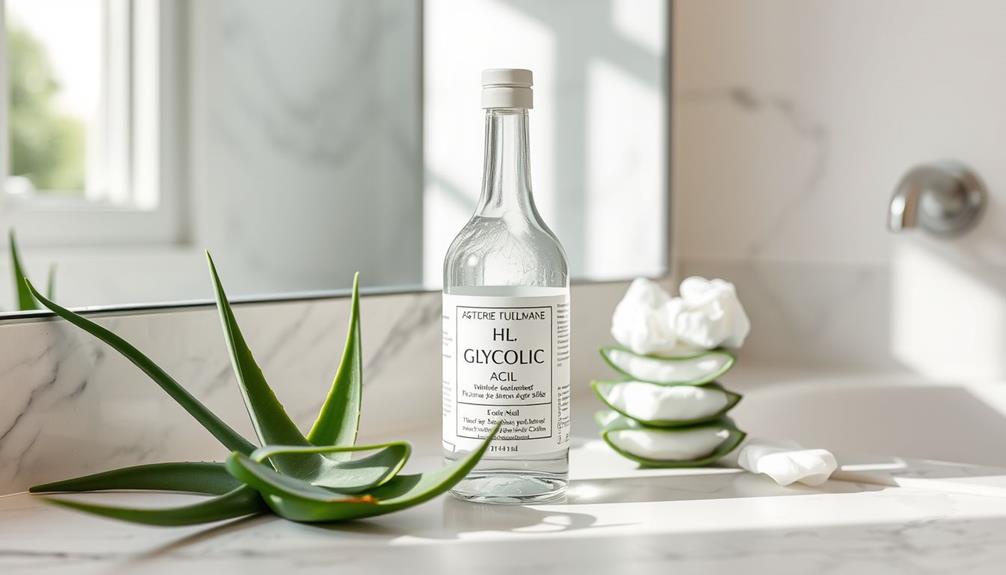
Using glycolic acid effectively requires some careful considerations to guarantee you get the best results without irritation.
Start with a concentration of 5% to 10%, using it two to three times a week as your skin allows. Conduct a patch test before applying it to your entire face to gauge your skin sensitivity and avoid any adverse reactions.
Apply glycolic acid in the evening to minimize the risk of sun sensitivity, and don't forget to slather on a broad-spectrum sunscreen with at least SPF 30 during the day.
After your treatment, incorporate a hydrating moisturizer to help soothe any potential dryness or irritation.
Keep a close eye on how your skin responds. If you notice redness, stinging, or excessive dryness, adjust your usage frequency or concentration accordingly.
Remember that effective use is about balancing the treatment with your skin's needs.
With patience and proper care, glycolic acid can be a powerful ally in your fight against acne, helping you achieve clearer, healthier skin.
Frequently Asked Questions
Does Glycolic Acid Make Your Skin Clear?
Yes, glycolic acid can make your skin clearer. It exfoliates dead skin cells, unclogs pores, and promotes cell turnover, leading to a smoother complexion. Regular use can greatly reduce acne and improve overall skin texture.
What Are the Benefits of Glycolic Acid on the Skin?
Glycolic acid offers numerous benefits for your skin. It exfoliates dead skin cells, enhances texture, and promotes cell turnover, leading to a smoother, brighter complexion. You'll also notice reduced fine lines and improved overall skin tone.
What Are the Results of Glycolic Acid on Skin?
Glycolic acid can transform your skin by promoting cell turnover, smoothing texture, and reducing acne lesions. You'll notice fewer clogged pores, decreased sebum production, and an overall improvement in skin tone and health with consistent use.
What Are the Results of Glycolic Acid for Acne Scars?
Imagine transforming your skin like a caterpillar into a butterfly; glycolic acid can greatly reduce acne scars. With consistent use, you'll notice smoother texture and more even tone, restoring your confidence and radiance.
Conclusion
In your journey to clearer skin, glycolic acid can be a powerful ally, gently exfoliating and revealing a fresh layer beneath.
Think of it as a key that opens your skin's potential, helping you battle acne and embrace your natural beauty.
By incorporating glycolic acid into your routine, you're not just treating blemishes; you're investing in yourself.
With patience and the right products, you can pave the way to a radiant, confident you.




